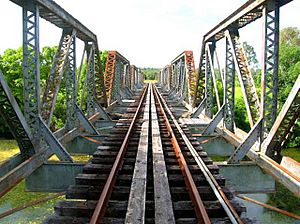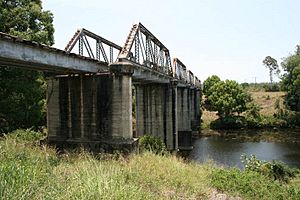Imbil Railway Bridge facts for kids
Quick facts for kids Imbil Railway Bridge |
|
|---|---|

Imbil Railway Bridge, view along the tracks, 2009
|
|
| Location | Over Yabba Creek, Imbil, Gympie Region, Queensland, Australia |
| Design period | 1900 – 1914 (early 20th century) |
| Built | 1915– |
| Official name: Imbil Railway Bridge | |
| Type | state heritage (built) |
| Designated | 14 October 2011 |
| Reference no. | 602791 |
| Significant period | 1915– |
| Builders | Queensland Railways |
| Lua error in Module:Location_map at line 420: attempt to index field 'wikibase' (a nil value). | |
The Imbil Railway Bridge is a special old railway bridge in Queensland, Australia. It crosses Yabba Creek near the town of Imbil. This bridge was built around 1915 by Queensland Railways. Its main purpose was to help more people settle and farm in the Mary River Valley.
The Imbil Railway Bridge is now considered a heritage site. This means it is an important part of Queensland's history and is protected. It was added to the Queensland Heritage Register on 14 October 2011.
Contents
A Bridge Through Time
The Imbil Railway Bridge is part of the Mary Valley railway line. This line is now famous for the Mary Valley Rattler tourist train. The bridge is about 35 kilometres (22 miles) from Monkland station.
The Mary Valley railway line was built between 1911 and 1915. It helped people move into the Mary River valley. The Imbil Railway Bridge shows how important the Mary Valley was for farming in Queensland during the 1900s. It is also a rare type of bridge called a "half-through Pratt truss" bridge. Only six of these bridges are still standing in Queensland today.
Early Days in the Mary Valley
People from Europe started settling in the Mary Valley in the 1850s. They set up large farms called pastoral leases. Later, a law in 1868 allowed some of this land to be divided into smaller farms. This helped more people move to the area.
From the late 1870s, more land became available for farming. This led to the growth of small farms and dairy businesses. Nearby Gympie was a gold mining town that grew quickly. It provided a good market for the farmers' produce. Farmers in the Mary Valley mainly grew maize (corn) and potatoes. They also tried growing tobacco, rice, sugar cane, peas, and pineapples.
The Railway Arrives
In the early 1900s, the Queensland government wanted to build more railway lines in country areas. This would help more people move there and boost farming. People in the Mary Valley had been asking for a railway line for many years.
In 1910, a plan for the Mary Valley railway was approved. It was expected to carry lots of farm produce, timber, animals, and dairy products. The line started at Monkland and went all the way to Brooloo. The Gympie City Council even helped pay for one-third of the building costs.
Work on the railway began in June 1911. By 1913, about 550 people were working on it. The line included four big bridges and one tunnel. The railway reached Kandanga in 1914 and Brooloo in April 1915. When the line opened, new towns like Kandanga, Brooloo, Imbil, Amamoor, and Dagun grew up near the train stops.
A Special Bridge Design
The Imbil Railway Bridge shows how railway bridges changed in the early 1900s. Engineers started using stronger designs like the "through" and "half-through Pratt trusses." These designs made bridges much stronger for trains.
The half-through Pratt truss design was used for lighter loads. It has top and bottom parts connected by vertical and diagonal bars. But it doesn't have cross-bracing at the very top between the two sides of the bridge. This makes it different from the "through Pratt truss" design.
Dairy Farming and the Railway
Between World War I and World War II, dairy farming in the Mary Valley grew a lot. The Gympie region became one of Queensland's best dairy areas. In 1925, the Wide Bay Co-Operative built a huge butter factory. By 1935, it was getting cream from 2,000 different farms.
By 1927, the Gympie area produced 10% of Queensland's milk. Most of this milk was used to make butter. In 1939, butter factories in the Wide Bay-Burnett region made almost one-third of all Queensland's butter. The railway was very important for transporting all this cream and butter.
Changes in Farming
In the 1950s, things started to change for dairy farmers. People in Australia began eating less butter. Also, a big market for butter was lost when Britain joined the European Economic Community in the early 1970s.
Farmers had to change from selling cream to selling milk. This meant they needed bigger herds and new equipment. Many small farmers stopped dairying or switched to raising beef cattle. Stricter rules, lower prices, and competition from margarine also made things harder. The last butter was made in Gympie in 1978.
From Freight to Fun: The Mary Valley Rattler
Even after dairy farming changed, the Mary Valley railway still carried fruit. However, the line became less and less profitable in the 1970s. By the late 1980s, it looked like the railway might close.
Pineapple growers in the area protested, which helped keep the line open for a while. But the last goods train ran in 1995. After that, pineapple growers took their produce to another station.
Even though the line was not formally closed, it seemed its days were numbered. But in 1996, the Mary Valley Heritage Railway group stepped in. They started running tourist trains on the line. The "Valley Rattler" steam train rides became a big tourist attraction. Many volunteers help to run and maintain the line and its old trains.
The Imbil Railway Bridge is a reminder of how important the Mary Valley was for Queensland's dairy industry. It is also a rare example of a half-through Pratt truss railway bridge.
What Does the Bridge Look Like?
The Imbil Rail Bridge is a large bridge made of steel and concrete. It crosses Yabba Creek high above the water. It is about 35 kilometres (22 miles) from Monkland on the Mary Valley railway line.
The bridge is 120 metres (393 feet) long. Its longest single section, called a span, is 18 metres (60 feet). The bridge has five steel "trusses." Trusses are strong frameworks of beams that support the bridge. It is also supported by two concrete ends called "abutments" and nine concrete pillars called "piers."
The bridge is built with:
- Sections of steel beams and decking at each end.
- Five 18-metre (60-foot) riveted 8-panel half-through Pratt trusses in the middle. These are the main strong parts of the bridge.
- Concrete piers with octagonal (eight-sided) ends.
The bridge still has its original rails and wooden sleepers (the ties that hold the rails).
Why is the Bridge Important?
The Imbil Railway Bridge is listed on the Queensland Heritage Register. This means it is very important for several reasons:
Demonstrating Queensland's History
The Imbil Railway Bridge, opened in 1915, was a major engineering project. It shows how the Queensland government used railways to help people settle in new areas. This railway helped the Mary Valley become a big farming region in Queensland.
The bridge is still in great condition. It shows how railway bridges were designed and built in the early 1900s. It also shows how steel railway bridge designs improved over time, especially with the use of Pratt trusses.
A Rare Design
The Imbil Railway Bridge is a rare type of railway bridge. Only 11 half-through Pratt truss bridges were built by Queensland's railway department in the early 1900s. Only six of these bridges are still standing today. The Imbil bridge is one of them and is still in excellent condition.
Other bridges of this type that still exist include:
- Harlin Rail Bridge, Harlin (1912)
- Sleeper Log Creek (1915)
- Saltwater Creek (1915)
- Crystal Creek (1916)
- Murray Creek (1923)
A Good Example of its Type
The Imbil Railway Bridge is a great example of a half-through Pratt truss railway bridge. This design was created by the Department of Railways and Public Works. As mentioned, this type of bridge has girders that are not tall enough for cross-bracing at the top, which is found in the "through Pratt truss" bridges.
The bridge has nine concrete piers, two abutments, five steel trusses, steel beams, decking, wooden sleepers, and steel rails.
A Beautiful Landmark
The Imbil Railway Bridge is also very beautiful. It looks striking with its tall concrete piers and steel trusses against the natural background of mountains, grassy fields, trees, and the river. You can see great views of the bridge from the road, the train, and the water.


